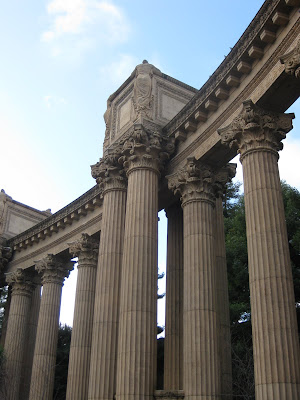
The task of creating Palace of Fine Arts for
the 1915 Panama-Pacific International Exposition
fell to architect, Bernard R. Maybeck.
The Panama-Pacific International Exposition 1915
was an event dedicated to progress,
the celebration of the completion the Panama Canal,
and the rebirth of San Francisco
following the disastrous 1906 earthquake.
Funds came from six million dollars in donations,
five million in state bonds
and five million in San Francisco taxes.


The Palace of Fine Arts was the last of the major buildings of the Exposition to be started; construction began in 8 December 1913.
was already under way,
signatures and money were gathered from the fine arts league.
signatures and money were gathered from the fine arts league.
For a while the Palace housed a continuous art exhibit,
and when the depression came, W.P.A. artists were commissioned
to replace the deteriorated murals on the ceiling rotunda.
In 1934, eighteen lighted tennis courts were installed and
remained there for eight years.
During this period, the Palace, without proper maintenance and
as a result of vandalism, was gradually crumbling into a genuine ruin.
Then during World War II it was requisitioned by the Army
Then during World War II it was requisitioned by the Army
for storage of trucks and jeeps.
Two years after the War's end,
Two years after the War's end,
the Palace was returned by the Army to the city.
By now, it had been declared unsafe of public use.
designed as a ruin, it should remain one.
But the building was not strong enough to last.
When Maybeck's opinion was solicited, he had this to say:
"I think the main building should be torn down and
redwood planted around, completely around the rotunda.
Redwood grows fast, you know.
Then as they grow, the columns of the rotunda would slowly crumble,
at approximately the same speed. Then I would like to design an alter,
with the figure of a maiden praying, to install in that grove of redwoods.
I shall like my Palace to die
behind those great trees of its own accord,
to become its own cemetery."
as City Park Department warehouse,
as a flag and tent storage depot and
even as temporary Fire Department Headquarters.
For several years, Assemblyman Caspar Weinberger, supported by other prominent San Franciscans, had patiently pushed the cause of the Palace.
For several years, Assemblyman Caspar Weinberger, supported by other prominent San Franciscans, had patiently pushed the cause of the Palace.
Finally between 1957 and 1959, his efforts were rewarded.
Funds from California State Legislature, the city and Palace of fine Arts League,
supplemented by a most generous $2,000,000 donation
(an later an additional donation of approximately $2,500,000)
from Walter S. Johnson, as well as large contributions from
other concerned residents of the city, saved the life of the Palace.
By 1962, a plan for its restoration in concrete had been
approved by the San Francisco Board of Supervisors.
The work of demolition and reconstruction began in 1964.
The exhibition hall which originally housed Impressionist
paintings during the Exposition, is now home to the Exploratorium,
a state of the art interactive science museum.












No comments:
Post a Comment